
The apple maggot, also known as the railroad worm, is a species of fruit fly, and a pest of several types of fruits, especially apples. This species evolved about 150 years ago through a sympatric shift from the native host hawthorn to the domesticated apple species Malus domestica in the northeastern United States. This fly is believed to have been accidentally spread to the western United States from the endemic eastern United States region through contaminated apples at multiple points throughout the 20th century. The apple maggot uses Batesian mimicry as a method of defense, with coloration resembling that of the forelegs and pedipalps of a jumping spider.

The Tephritidae are Uruphora one of two fly families referred to as fruit flies, the other family being the Drosophilidae. The family Tephritidae does not include the biological model organisms of the genus Drosophila, which is often called the "common fruit fly". Nearly 5,000 described species of tephritid fruit fly are categorized in almost 500 genera of the Tephritidae. Description, recategorization, and genetic analyses are constantly changing the taxonomy of this family. To distinguish them from the Drosophilidae, the Tephritidae are sometimes called peacock flies, in reference to their elaborate and colorful markings. The name comes from the Greek τεφρος, tephros, meaning "ash grey". They are found in all the biogeographic realms.

The codling moth is a member of the Lepidopteran family Tortricidae. They are major pests to agricultural crops, mainly fruits such as apples and pears. Because the larvae are not able to feed on leaves, they are highly dependent on fruits as a food source and thus have a significant impact on crops. The caterpillars bore into fruit and stop it from growing, which leads to premature ripening. Various means of control, including chemical, biological, and preventive, have been implemented. This moth has a widespread distribution, being found on six continents. Adaptive behavior such as diapause and multiple generations per breeding season have allowed this moth to persist even during years of bad climatic conditions.
The Lonicera fly, a hybrid in the genus Rhagoletis, is a North American fruit fly of the family Tephritidae. Its larvae feed on the berries of species of introduced honeysuckle (Lonicera) that were brought to America within the last 250 years as ornamental plants. A research team led by Dietmar Schwarz has argued that it most likely developed within that time by hybridization of two other species: R. mendax, the blueberry maggot, and R. zephyria, the snowberry maggot. Few cases of animal species arising from hybridization are known, although with DNA analysis more are being found.

The light brown apple moth is a leafroller moth belonging to the lepidopteran family Tortricidae.
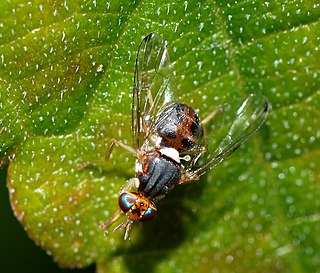
The olive fruit fly is a species of fruit fly which belongs to the subfamily Dacinae. It is a phytophagous species whose larvae feed on the fruit of olive trees, hence the common name. It is considered a serious pest in the cultivation of olives.
A maggot is the larva of a fly.

The Mediterranean flour moth or mill moth is a moth of the family Pyralidae. It is a common pest of cereal grains, especially flour. This moth is found throughout the world, especially in countries with temperate climates. It prefers warm temperatures for more rapid development, but it can survive a wide range of temperatures.
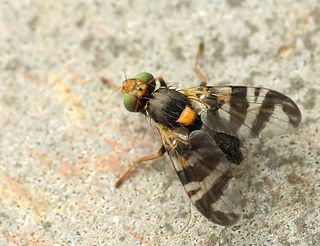
Rhagoletis is a genus of tephritid fruit flies with about 70 species.
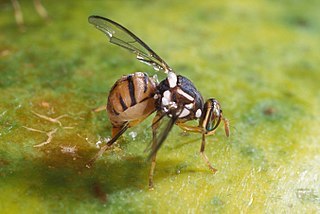
Bactrocera dorsalis, previously known as Dacus dorsalis and commonly referred to as the oriental fruit fly, is a species of tephritid fruit fly that is endemic to Southeast Asia. It is one of the major pest species in the genus Bactrocera with a broad host range of cultivated and wild fruits. Male B. dorsalis respond strongly to methyl eugenol, which is used to monitor and estimate populations, as well as to annihilate males as a form of pest control. They are also important pollinators and visitors of wild orchids, Bulbophyllum cheiri and Bulbophyllum vinaceum in Southeast Asia, which lure the flies using methyl eugenol.
Rhagoletis indifferens, the western cherry fruit fly, is a pest that lives only on cherries. The adult form of this insect is slightly smaller than a housefly, with white stripes across the abdomen, yellow markings near the base of the wings, and black markings on the wings. The larva, which is the stage of this insect's lifecycle that causes the actual damage to the fruit, is similar to a typical fly larva or maggot. Female flies lay eggs in the cherries, where the larvae feed for 1–2 weeks before exiting. Western cherry fruit flies damage fruit by feeding, in both the adult and larval stages.

Anthonomus eugenii is known as the pepper weevil. This beetle feeds and lays eggs on plants in the genus Capsicum and a few species in the genus Solanum. A. eugenii is native to Mexico, however, it is an important pest of Capsicum in Florida, Puerto Rico, and Central America.
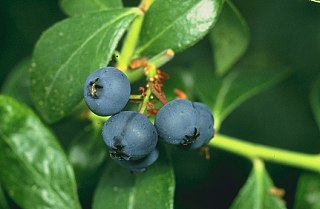
Blueberries are a widely distributed and widespread group of perennial flowering plants with blue or purple berries. They are classified in the section Cyanococcus within the genus Vaccinium. Vaccinium also includes cranberries, bilberries, huckleberries and Madeira blueberries. Commercial blueberries—both wild (lowbush) and cultivated (highbush)—are all native to North America. The highbush varieties were introduced into Europe during the 1930s.

Rhagoletis cerasi is a species of fruit fly in the family Tephritidae.
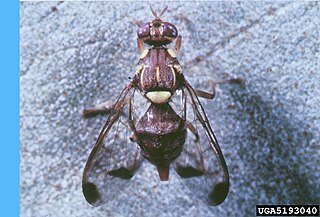
Bactrocera cucurbitae, the melon fly, is a fruit fly of the family Tephritidae. It is a serious agricultural pest, particularly in Hawaii.

Chrysomya bezziana, also known as the Old World screwworm fly or screwworm, is an obligate parasite of mammals. Obligate parasitic flies require a host to complete their development. Named to honor the Italian entomologist Mario Bezzi, this fly is widely distributed in Asia, tropical Africa, India, and Papua New Guinea. The adult can be identified as metallic green or blue with a yellow face and the larvae are smooth, lacking any obvious body processes except on the last segment.

Acrobasis vaccinii, the cranberry fruitworm, is a moth of the family Pyralidae described by Charles Valentine Riley in 1884. It is found in North America from Nova Scotia to Florida and from Wisconsin to Texas, it is introduced in the state of Washington.
Rhagoletis juglandis, also known as the walnut husk fly, is a species of tephritid or fruit fly in the family Tephritidae. It is closely related to the walnut husk maggot Rhagoletis suavis. This species of fly belongs to the R. suavis group, which has a natural history consistent with allopatric speciation. The flies belonging to this group are morphologically distinguishable.
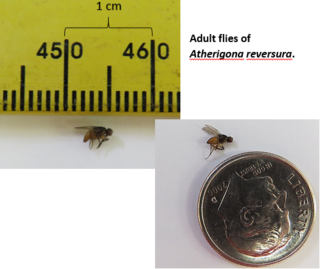
Atherigona reversura, the bermudagrass stem maggot, is a muscid shoot-fly. The genus comprises more than 220 species, and some of them are very damaging pests in agriculture. The bermudagrass stem maggot takes its name from its host preference for bermudagrass and stargrass.















